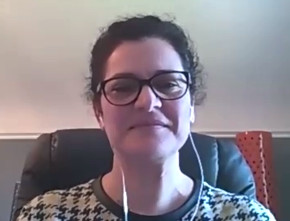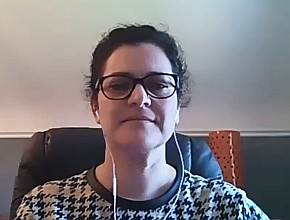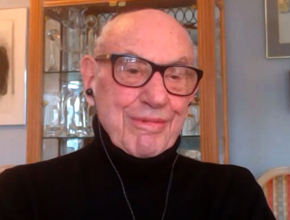Dr Zainab Samaan, associate professor in the Department of Psychiatry and Behavioral Neurosciences at McMaster University, talks to Dr Roman Jaeschke about cognitive behavioral therapy and the role of therapist-delivered and self-help programs to deal with mood disorders.
Additional resources
- moodgym, an online self-help program
- BounceBack, a free skill-building program from the Canadian Mental Health Association
- MindShift CBT, a free app developed by Anxiety Canada
- Big White Wall, an online service and community
- CBT is also available through the Mood Disorders program at St Joseph’s Healthcare Hamilton (referral required)
Transcript
Roman Jaeschke, MD, MSc: Good afternoon. Welcome to another edition of McMaster Perspective. The original impulse to talk to Dr Samaan was an article in which a type of psychotherapy called cognitive behavioral therapy (CBT) was delivered—because of coronavirus disease 2019 (COVID-19)—through electronic means of communication rather than person to person. That intrigued me, but the other thing that intrigued me was the frequency with which I heard about CBT and—to some degree—lack of knowledge, both in myself and among my colleagues, of what it really means. So I decided to ask Dr Samaan to tell us about it. The floor is yours.
Zainab Samaan, MSc, PhD: Thank you. Cognitive behavioral therapy, or CBT, is a very common term that has been around for a long time. In summary, it is different components, it’s not one thing, and there are different ways of delivering the therapy.
From its name, “cognitive” addresses how we think about ourselves and our world and what negative thoughts we have that make us feel sad and depressed and give us the feeling life is not worth living. The behavioral part of it is the actions and behavior that we take that perpetuate low mood and sadness. These maladaptive ways, the things that we don’t do to help with improvement in mood, are the target for the therapy.
There are different models and there are different components to each model. To start with, CBT is a weekly program and people attend a session per week. Depending on the progress of the person, it lasts 12 weeks, sometimes longer or shorter. It’s a lot of commitment in time but also in homework. The premise of it is that if we change how we think about certain things, about ourselves, and about our world, and if we act differently, that will help our mood to get better. We have more antidepressant behaviors and we have more engagement with our lives. We are returning to a level of function and satisfaction that we had before depression started.
So CBT is a lot of different things. It’s not a simple thing, like “Let’s talk about your past” or “Let’s talk about what’s bothering you.” It’s a lot of targeting specific thoughts, for example, automatic thoughts. Automatic thoughts are the thoughts that come to my mind when I’m doing something and it’s not going well, or when I fail a test, or I didn’t get the job that I wanted. My automatic thought is, “It’s me. I’m a failure. I’m a bad person. I didn’t do well. I don’t deserve this.” And that feeds more and more into that negative thinking. My behavior and reaction to that will be to withdraw. I’m not going to apply for the next job. I am not going to do this test again because I just can’t. That perpetuates the depression.
CBT is addressing those automatic thoughts. For example, I need to keep a thought record [and write down] what was going on in my mind when I did this or when I felt so bad. Why was my mood so bad this morning? What was I thinking before? What was my automatic thought? And then what did I do in reaction? Did I just close the door and say, “I’m not going out, I’m not doing anything, I’m not connecting with anyone?” It’s a lot of self-reflection and a lot of recognition of thinking and behavior.
It’s a great therapy for certain people, but not for everybody, because it’s a really quite involving and engaged process. And it’s progressive learning. It’s learning a skill. It’s a therapy based on teaching people about their own feelings, core beliefs, what has been ingrained throughout their life. We are all raised in different environments. We are all told as children and as adults which things that we do are good and which are not. These get ingrained in us as core beliefs.
Psychotherapy, the cognitive part of it, addresses our core beliefs a lot and targets symptoms of depression, such as guilt. If things go wrong, it’s always my fault. I feel responsible for it. I’m just not a good person. I’m not competent. These stem from these core beliefs and negative thoughts.
Then, there are also the behaviors. For example, if I have a plan to do something and I let my mood dictate that action, then if I’m not feeling too well and I’m not going to do that something, I go back into the negative cycle: I’m avoiding, I’m having depressant behaviors. With the behavioral part of CBT, we say, “Go with the plan, not with the mood.” If you’re planning on doing something, go with it, ignore your mood. With time it becomes more of an automatic action, without the effort, while when you are going through the therapy, it’s a lot of effort and commitment. The goal of it is the more you practice, the better you get at it. And then it becomes more of a normal reaction to your daily life.
Roman Jaeschke: You’re talking about the patient getting better, right? So you can effectively control what controls your behavior and change this?
Zainab Samaan: Exactly.
Roman Jaeschke: I work in an obesity clinic. I’ve seen a lot of people—we obviously are talking about depression, but probably the mechanism will be the same in anxiety or in weight disorders and so forth. You feel unwell, you eat, you feel even worse. And that perpetuates itself.
Zainab Samaan: Exactly. And these are the depressant behaviors. The model of CBT can be adapted to all of these different problems, but the examples and the focus would be on the pathology of the problem.
[Let’s look at] your example, the eating behavior, where you’re feeling so bad about yourself. I sometimes work with an obesity clinic as well and people say, “What’s the point? I already have this problem, I might as well eat.” That feeds into your negative automatic behaviors but also into that core belief that I’m really not going to make it. It’s just not going to be possible.
So, CBT can be a really good skill to have for the patients, physicians, therapists, and really everyone, to figure out why you are feeling a certain way. What is going on? Why am I reacting this way? A lot of thinking and a lot of changing of behavior can help, especially if you have a depressive disorder. But it’s also helpful with everyday life for people who are not necessarily having a disorder of a severity that requires the treatment.
Roman Jaeschke: Are there any resources which people could use electronically without interaction? Because it’s extremely time-consuming, also on the therapist’s side. Is there any such place?
I’ll tell you why I am asking. I wrote down the definition of CBT from your chapter [see Depressive Disorders], and it deals with identification and treatment of maladaptive behavior, cognitive distortion, and negative views of yourself, the world, and the future. I have an impression that we all are in this spot from time to time, if not most of the time. It would be very useful to go somewhere where you could get some help dealing with it. Is there a place like this?
Zainab Samaan: Yes. It’s a really good point. That was the whole purpose of doing the review that you’ve mentioned earlier in our interview. Because this is time-consuming and requires a lot of commitment on the side of the therapist but also on the side of the person who needs the therapy, we wanted to see if electronically delivered CBT would be at least as good as face-to-face therapy. Based on our review, after identifying and meta-analyzing 14 different trials, we found that both therapies were helpful in reducing depressive symptoms and that electronic therapy was even more helpful. Even though the trials themselves did not mention why it could be better, it is very likely what you’ve just said: time, commitment, and engagement. I can’t put in 2 hours of the same day of the week to attend the therapy or I have a full-time job or other responsibilities. So, accessibility, flexibility.
The therapies we’ve tested in this review were therapist-delivered, which means there is a human element and there is accountability. It’s not just an app or a program that is generated automatically. I think that’s the benefit as well. When you attend these therapies, sometimes the motivation that someone is going to look at your homework, give you the feedback, and guide you through the process is a great incentive for people to do it. If it’s an app on your phone or on your computer, you can take it or leave it because no one is checking your progress.
But despite all of that, there are a lot of things that are available online, not necessarily therapist-led. There is moodgym, for example, a very good app that people use to track mood and encourage activity scheduling. It’s a part of CBT to have a structure. Having a structure, having a purpose, and having an engagement give us some motivation to carry on. So, moodgym is one of them. There are also a lot of other things.
Roman Jaeschke: Perhaps I could ask you for 1 or 2 names that we could put on the screen at the end of the interview for people to write down.
But generally speaking, it is better if there is a therapist on the other end. It was very helpful to me to understand. Maybe I will look at some of those apps that you recommend myself.
We’ll see if we get any questions or responses from our listeners. In the meantime, I really appreciate your time. Thank you very much. I feel better. It was a useful session.
Zainab Samaan: Thank you very much and thank you for having me.
Roman Jaeschke: Thank you Dr Samaan. Goodbye.
 English
English
 Español
Español
 українська
українська











